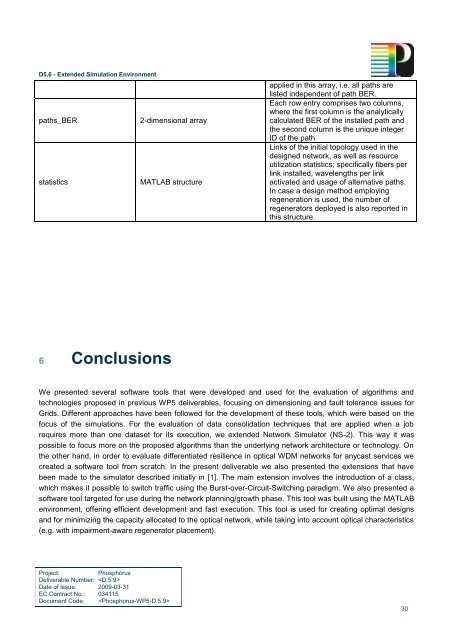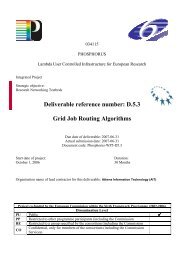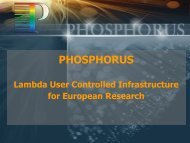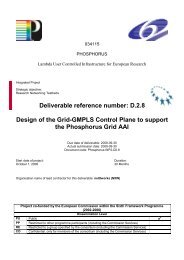D5.9: Extended Simulation Environment - Phosphorus
D5.9: Extended Simulation Environment - Phosphorus
D5.9: Extended Simulation Environment - Phosphorus
Create successful ePaper yourself
Turn your PDF publications into a flip-book with our unique Google optimized e-Paper software.
D5.6 - <strong>Extended</strong> <strong>Simulation</strong> <strong>Environment</strong><br />
paths_BER<br />
2-dimensional array<br />
statistics<br />
MATLAB structure<br />
applied in this array, i.e. all paths are<br />
listed independent of path BER.<br />
Each row entry comprises two columns,<br />
where the first column is the analytically<br />
calculated BER of the installed path and<br />
the second column is the unique integer<br />
ID of the path<br />
Links of the initial topology used in the<br />
designed network, as well as resource<br />
utilization statistics; specifically fibers per<br />
link installed, wavelengths per link<br />
activated and usage of alternative paths.<br />
In case a design method employing<br />
regeneration is used, the number of<br />
regenerators deployed is also reported in<br />
this structure.<br />
6 Conclusions<br />
We presented several software tools that were developed and used for the evaluation of algorithms and<br />
technologies proposed in previous WP5 deliverables, focusing on dimensioning and fault tolerance issues for<br />
Grids. Different approaches have been followed for the development of these tools, which were based on the<br />
focus of the simulations. For the evaluation of data consolidation techniques that are applied when a job<br />
requires more than one dataset for its execution, we extended Network Simulator (NS-2). This way it was<br />
possible to focus more on the proposed algorithms than the underlying network architecture or technology. On<br />
the other hand, in order to evaluate differentiated resilience in optical WDM networks for anycast services we<br />
created a software tool from scratch. In the present deliverable we also presented the extensions that have<br />
been made to the simulator described initially in [1]. The main extension involves the introduction of a class,<br />
which makes it possible to switch traffic using the Burst-over-Circuit-Switching paradigm. We also presented a<br />
software tool targeted for use during the network planning/growth phase. This tool was built using the MATLAB<br />
environment, offering efficient development and fast execution. This tool is used for creating optimal designs<br />
and for minimizing the capacity allocated to the optical network, while taking into account optical characteristics<br />
(e.g. with impairment-aware regenerator placement).<br />
Project:<br />
<strong>Phosphorus</strong><br />
Deliverable Number: <br />
Date of Issue: 2009-03-31<br />
EC Contract No.: 034115<br />
Document Code: <br />
30






